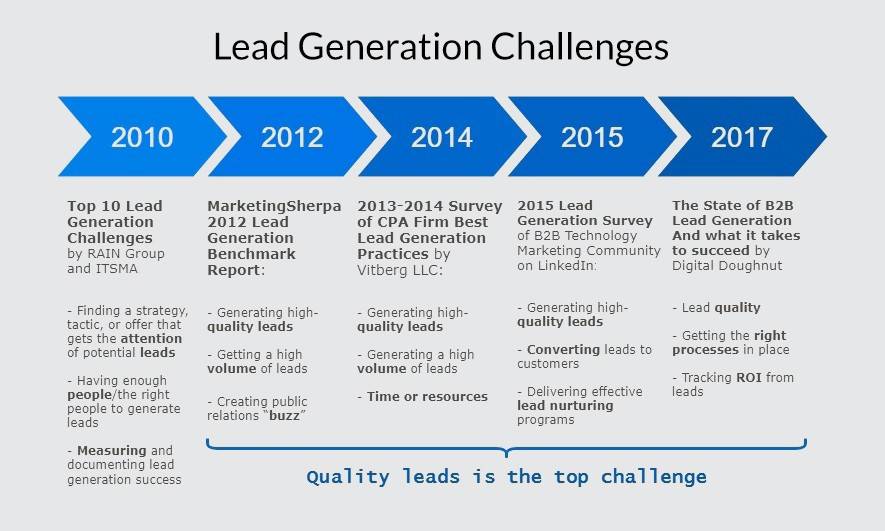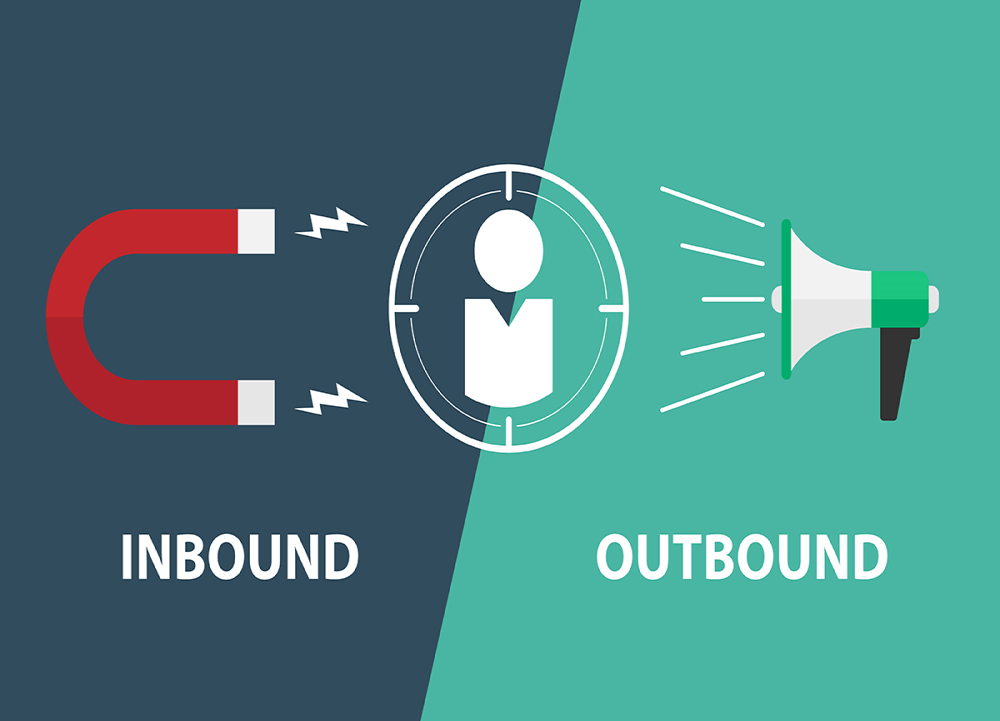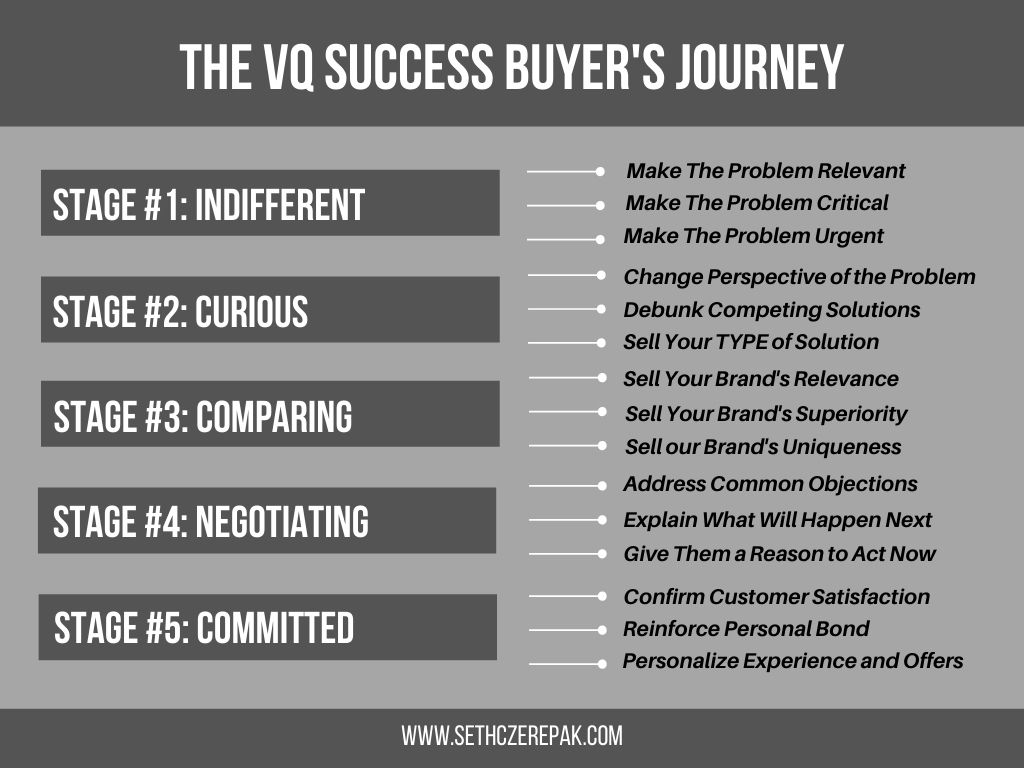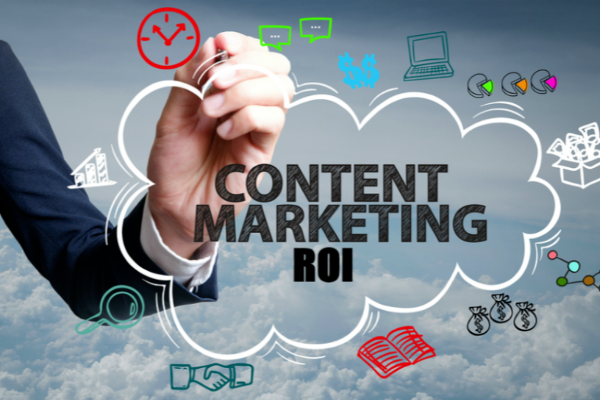5 Benefits of a Content Marketing Strategy
Content Marketing Strategy: a type of marketing plan focused on creating and distributing relevant, valuable information with the goal of attracting a clearly-defined audience and engaging them to take a specific action.
Topics Covered in This Article
Benefits of a Content Marketing Strategy
This article reveals the top five Benefits of a Content Marketing Strategy, which include:
This article explains each of these benefits and gives objective data and arguments to support each one. These benefits apply whether you’re working with a good Content Marketing Agency, or managing an internal Content Marketing Team or department. You’ll find detailed strategies and examples for achieving these benefits in our Content Marketing Strategy and Best Practices article and our other tutorials on content marketing and SEO.
Content Marketing Strategy Benefit #1: Inbound Leads
The most popular benefit of implementing a content marketing strategy is inbound lead generation. According to a 2017 CMI Report, content marketing generates three times as many leads as outbound marketing and is 62% less expensive. Inbound leads also tend to be more value-driven and willing to pay premium prices for superior products or services.
Since 2010, marketing research has consistently revealed lead generation as the biggest challenge facing modern businesses (see the “Lead Generation Challenges” infographic).
In my business coaching experience (since 2003), I’ve also found that small B2B startups (ten employees or less) invest nearly half their time into cold-calling or networking for leads. This leaves them with less time for providing excellent service to their clients.

Source: Cience Article citing multiple studies in one infographic.
If the business owner is involved in this process, it chews up their mental bandwidth and reduces their capacity to plan and implement new product lines or marketing strategies. This perpetual cycle of “chase leads – get overloaded – catch up on service fulfillment – chase more leads…” traps most startup companies in the roach-hotel-like nightmare of entrepreneurial purgatory. Inbound lead generation solves this problem as well.
It also makes your business more resilient to economic downturns. In my time (since 2008) working with sales and marketing managers, I’ve found that “lead scarcity” is the most telling sign of how economically vulnerable a business is. Companies that depend heavily on cold-calling or paid advertising, or who have intermittent waves of inbound leads followed by periods with little to no leads are highly vulnerable to economic slumps like the 2008 housing crisis and the 2020 COVID-19 shutdowns.

A good content marketing strategy helps to solve this problem by creating a marketing machine that attracts an evergreen stream of qualified inbound leads. It’s hard to overstate how dramatically this can transform your business.
The more qualified inbound leads you to attract, the more time you’ll have to serve your clients, increase your referral rates, and grow your average revenue per client. It frees up small businesses and startups to focus on serving customers and creating scalable business growth.
Having a steady march of inbound leads also empowers you to build your own audience and create a brand that can withstand sudden disruptive changes made by marketing platforms (i.e., email and SMS marketing regulations, AI-based search engine updates, social media shadowbans). This is how a content marketing strategy can insulate your brand from economic slumps and reduce your dependency on media giants like Google, Facebook, and Amazon.
Finally, inbound leads are typically willing to pay more for a superior product or service. Just ask any experienced salesperson whether they get more price resistance from an inbound lead or a prospect they found through cold calling. For these reasons, inbound lead generation is the most popular of the five benefits of a content marketing strategy.
Content Marketing Benefit #2: Earlier Engagement
Buyer’s Journey: the stages of awareness and interest a buyer progresses through leading up to their decision to purchase a product or service. These stages include: indifferent, curious, comparing, negotiating, committed.
Content marketing is the best way to engage your prospects early in the buying cycle. In content marketing, we call this buying cycle the “Buyer’s Journey.” Most marketers only focus on prospects in Stage #3 of the Buyer’s Journey. Stage #3 Prospects are people actively looking for the type of product or service you sell.
The problem is, that prospects in this stage are being aggressively marketed by your competitors. They’re also likely to already have a bias toward one of your more popular or familiar competitors.

Imagine if this bias was toward your brand instead of one of your competitors. When done right, content marketing helps you accomplish this by capturing your prospect’s attention and building a relationship with them at the start of the Buyer’s Journey. It’s hard to overstate how powerful this benefit is, especially if you’re selling a higher-end service. We know that our prospects don’t wake up in the morning saying:
“It’s a great day to go shopping! I’m going to sign up for Seth Czerepak’s Content Marketing Course today! I know there are other Content Marketing Courses available for only a fraction of the price. But Seth’s course is worth paying more money because it’s the best Content Marketing Course on the market!”
This would be nice. But in the real world, prospects have likely never heard of our brand. They might know very little about the type of product or service we sell or even have misconceptions about it. Content marketing helps you connect with these prospects early, educate them about the problem they’re trying to solve, debunk competing solutions, and sell them on the type of product or service you sell.
By the time they become a Stage #3 Prospect, YOU will be the brand they’re most familiar with. If you follow the strategy in our Buyer’s Journey vs Customer Journey article, your prospect also has a bias toward your brand. Most importantly, they’ll be more open to paying premium prices for what they perceive to be a better quality product or service.
A good content marketing strategy helps you capture your prospect’s attention early, build a relationship with them, and box out your competition before your prospect even knows who they are. This benefit is especially powerful when combined with the benefit of Thought Leadership, as described below.
Content Marketing Benefit #4: Thought Leadership
Thought Leadership: when an individual or an organization is considered an authority in a particular field or industry. The insights and advice of thought leaders are recognized, on an industry-wide or even worldwide basis, by laypeople and even by other experts in the thought leader's field or industry.
Thought leadership is how you become a one-of-a-kind authority in your field or industry. The legendary composer Ludwig Van Beethoven once said this to a member of the Austrian nobility:
“What you are, you are by accident of birth; what I am, I am by myself. There are and will be a thousand princes; there is only one Beethoven.”
Beethoven was indeed a Thought-Leader and remains one of the great legends in music history. Yet, many of his contemporaries faded into obscurity because they were ordinary and replaceable.

Today, every field and every industry is full of people and companies who have been marginalized as commodities. They don’t stand out as one-of-a-kind leaders and are thus forced to compete based on price and to rely on networking and other non-scalable lead generation methods. Meanwhile, Thought Leaders get paid more for what they do and almost always have a waiting list for new clients.
The 2019 Edelman-LinkedIn B2B Thought Leadership Impact Study, surveyed 1,200 US business decision-makers, content creators, and salespeople to see how they perceived the value of the companies or service providers they did business with. The survey focused primarily on the value of Thought Leadership.
The survey results showed that most B2B marketers and salespeople grossly underestimate the impact Thought Leadership (or lack of it) has on their sales and marketing results. For example, it showed that 55% of decision-makers claimed to use Thought Leadership as a means of vetting business. Decision-makers also said that if they don’t see a strong Thought Leadership presence, they drop a business from consideration.
Here are a few more relevant findings from the survey:
The most striking thing about this survey was the disconnect between how important Thought Leadership was to company decision-makers compared to how important salespeople and marketers believed it to be.
For example, 61% of decision-makers said they were willing to pay premium prices to work with brands that show a clear vision through Thought Leadership. However, only 14% of marketers and salespeople believed Thought Leadership allowed them to charge higher prices than their competitors.
Bottom line, your sales and marketing efforts pay off more when your prospects see you as a one-of-a-kind expert in your field or industry. A good Content Marketing Strategy is the best way to achieve this. It empowers you to connect with your prospects earlier in the buying cycle and to demonstrate your knowledge and expertise through your published content.
Content Marketing Benefit #3: Increased ROI
Content Marketing ROI: is a percentage that shows how much revenue you gained from content marketing in comparison to what you spent. ROI is said to be one of the most important measures of successful content marketing because it's directly tied to revenue.
There are multiple ways a Content Marketing Strategy can increase your ROI. We discuss these in detail in our article on How to Track Content Marketing ROI.
Firstly, Content Marketing helps you engage with prospects earlier in the buying cycle. It also increases your perceived value with decision-makers through Thought Leadership.
However, a good Content Marketing Strategy also helps you track your Content Marketing KPIs, find the weak links in your content marketing funnel, and improve them.

Moreover, a good Content Marketing Strategy helps you build trust over time with your prospects through follow-up marketing, like email, SMS, messaging, and other Continuity Strategies. Here are just a few statistics on the bottom-line value of follow-up marketing:
Finally, a good Content Marketing Strategy helps you gain valuable insights about your target audience through the strategies discussed in our article on How to Create a Buyer’s Persona, our articles on How to Create a Content Distribution Strategy, and How to Track Content Marketing Goals and KPIs. Most marketers, including those using content marketing, are playing what Dan S Kennedy calls “Blind Archery” with their marketing efforts.
They hardly track their Content Marketing KPIs, and most of them know little or nothing about how to build a Consumption Strategy or to use their KPI data to do objective revenue forecasting. They simply create marketing campaigns hoping that they’ll work. When they do work, the marketer doesn’t know how to optimize them and increase their ROI. When they don’t, the marketer learns little or nothing from the results they did get.
However, the eight-step Content Marketing Strategy we introduce at the end of this article solves all these problems, and more. It gives you a clear and actionable blueprint for creating and distributing content that gets you consistent results and helps you gain valuable insights that will inform all your marketing efforts.
Content Marketing Benefit #5: Content Equity
Content Equity: the cumulative value of a brand's published content in terms of its capacity to attract and convert customers and to increase ROI by improving marketing KPIs (lead capture rates, cost per lead, conversion rates, cost per acquisition, value per transaction, value per customer, etc.).
Imagine you run a local service business. You have hundreds of positive reviews published on trustworthy sites like Yelp, Trustpilot, and Google My Business.
These customer reviews bring you a steady flow of inbound leads, even when you’re not looking for new business. Your potential customers find these reviews while searching for the type of service you offer, and even when researching your competitors.
By the time these prospects talk to someone at your company, they’re closer to a buying decision. They’re also more willing to pay premium prices since they perceive your service to be superior to your competitors. This is a simple example of content equity that most people can easily understand.
You can build a similar kind of content equity by publishing credible, relevant, and well-crafted articles, videos, infographics, white papers, and podcasts. If this content is consistently showing up at the top of search results, being shared on social media, and being linked to on other people’s websites, this body of published content will attract a steady flow of inbound leads, even when you’re not looking for new business.
This is what I mean by content equity. Now, imagine building a content marketing strategy that uses high-quality website articles to secure and sustain top search engine rankings. What would be the cumulative value of that content in terms of its capacity to expose your brand to more prospects, increase your perceived authority, and attract more inbound leads? Let’s look at some data based only on the Google search results.
A 2013 Report revealed that 95% of website visitors never scroll past the first page of the Google Search Results. Another report, in 2017, revealed that the first page of Google captures 71% of search traffic clicks. Again, in 2019, the click-through rates for the top ten positions in the Google Search Results broke down like this:

Source: 2019 Google CTR Stats from BackLinko.com
Google Page One Click-Through Rates
Notice the exponential increase between Position #10 and Position #1. This increase proves that having several pieces of relevant, well-crafted, high-ranking content will increase your brand exposure, attract more inbound leads, and dramatically boost your perceived authority in the marketplace.
This is one of many examples of what content equity will do for your business. Other examples might include articles in popular print magazines, social media mentions, links, or guest articles on reputable websites, just to name a few. It’s hard to overstate how powerful this can be to your bottom line and to the long-term resilience of your brand.
On the other hand, brands with low (or non-existent) content equity are highly dependent on paid advertising platforms. They’re also vulnerable to economic slumps and to being shadowbanned or censored on social media. Content Equity solves these challenges by giving you a steady flow of qualified inbound leads.
It improves the overall performance of ALL your marketing campaigns and even gives you the leverage to intercept traffic generated by your competitors through their paid ads. If your leads start to drop off as soon as you slow your marketing efforts, this is a clear sign that you need to start building your content equity.
How to Reap The Benefits of a Content Marketing Strategy
We hope you enjoyed this article on the Benefits of a Content Marketing Strategy.
Good content marketing starts with a solid Content Marketing blueprint. This blueprint gives you the specific steps for setting and tracking your content marketing goals and KPIs, creating your buyer persona(s), your content distribution plan, your content creation plan, your cost-benefit analysis, and your internal promotion strategy.
Starting with a written content marketing blueprint increases your odds of long-term success. It also gives you an objective way to measure your progress and plan improvements.
I unpack each step of the VQ Success signature eight-step content marketing blueprint in our Content Marketing Strategy and Best Practices article. This blueprint is based on The Antifragile Sales System. I started designing this system back in the early 2000s while working as a call center manager.

I’ve also been using, testing, and refining this blueprint since 2009 when I started my freelance copywriting career. I’ve used this simple eight-step blueprint to build complex multi-step content marketing systems (offline and online) for hundreds of clients. In 2012, Copywriting Legend Dan S Kennedy reviewed and endorsed this eight-step system:
The Eight Step Antifragile Content Marketing Strategy
Implementing a content marketing strategy requires discipline, patience, hard work, and critical thinking. This is why companies invest five or six figures a year into building their own content marketing team (or department) or hiring a content marketing agency. If you’re ready to discover what a content marketing strategy will do for your business, fill in the form below and tell us how we can help.
This concludes our article on the Benefits of a Content Marketing Strategy.
-Best

